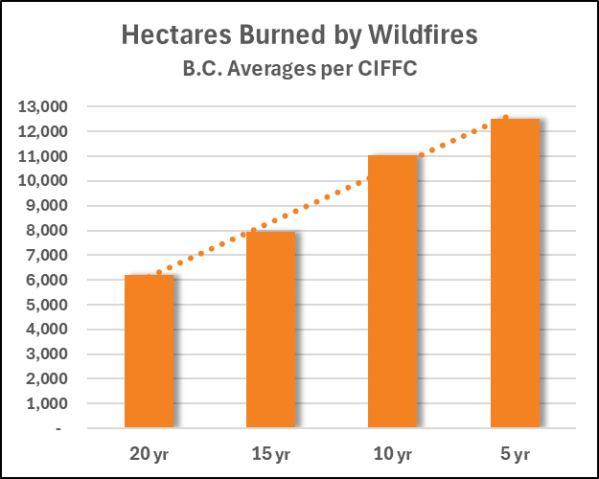The concentration of greenhouse gases (GHGs) in the atmosphere is a critical environmental issue. One important cause involves the production and use of fossil fuels. Canada’s government just released the National Inventory Report (NIR) detailing GHG emissions for the years up to 2022. It provides useful information, but it is incomplete.
A major exclusion from the NIR involves wildfires. Officials say that emissions from burning forests are not human-caused and therefore not counted. Yet scientists hold that climate change and human activities have resulted in more frequent and intense forest blazes over the past 20 years.
According to data from the EU’s Global Fire Assimilation System data, Canadian wildfires released about 480 megatonnes of carbon in 2023, almost a quarter of global wildfire emissions. Last year’s experience may seem like a one-off, but a worrisome trend has become well established in the last two decades.

Forests have been burning with greater severity and scale. Canadian wildfires in 2023 were remarkable for their impact on affected communities and for effects on the health of vulnerable individuals. The amount of carbon released to the atmosphere was also remarkable.

Nevertheless, those emissions are excluded from the federal government report that purports to inform Canadians about GHG emissions. The Office of the Auditor-General of Canada says that variability of wildfire emissions means that including them in the annual inventory would mask the picture of what is happening with human-caused emissions.
That seems a rationalization used to quiet calls for greater action on climate change. An important statement of the Auditor-General’s Office was this:
Canada’s forests are becoming a net source of emissions because of forest fires and disturbances caused by insect outbreaks, such as the mountain pine beetle.
The oft-repeated assertion that forests are carbon sinks is simplistic. A report by four environmental groups reminds us of the importance of protecting ancient forests. However, short-term commercial interests invariably take precedence over the long-term survival of humanity.
Forests, in addition to their importance in maintaining biodiversity, play an irreplaceable role in global carbon regulation, absorbing one-third of human-caused carbon emissions from the atmosphere annually and storing this carbon long-term in their soil and vegetation. This is why forest protection and restoration are key pillars of international efforts to advance natural climate solutions…
Preserving primary forests, which are forests that have never been impacted by significant human disturbance, is particularly critical. These forests, which are rapidly disappearing, hold unique value for the climate and biodiversity. Once gone, they are irreplaceable on any meaningful human timescale.
MISSING THE FOREST: HOW CARBON LOOPHOLES FOR LOGGING HINDER CANADA’S CLIMATE LEADERSHIP

National Resources Defence Council is an international nonprofit environmental organization. Based in New York, it employs lawyers, scientists, and environmental specialists to protect natural resources, public health, and the environment.

Nature Canada represents a network of more than 100,000 supporters and engages a community of 900+ nature organizations across the country. It is focused on reversing species loss, supporting Indigenous-led conservation, and encouraging people to embrace a culture of conservation in their everyday lives.

Environmental Defence Canada is an advocacy organization that works with
government, industry and individuals to defend clean water, a safe climate and healthy communities.

Nature Québec takes action in projects relating to biodiversity, forests, energy and climate, as well as the urban environment. Nature Québec raises awareness, mobilizes and acts for a more just society, with a low ecological and climatic footprint, in solidarity with the rest of the planet.
Another problem with the recent federal NIR is that researchers have provided convincing proof that emissions of methane, a potent greenhouse gas, have been routinely underreported.
If we remember limitations of the NIR, it allows us to examine where reported GHG emissions originate. Per capita GHG releases in Alberta and Saskatchewan are 5.6 times those listed for the rest of Canada.

People in British Columbia have little influence on choices made in other provinces but we can examine the record of our own government. According to the David Eby’s administration, the province is “committed to reducing greenhouse gas emissions by 16% below 2007 levels by 2025, 40% by 2030, 60% by 2040 and 80% by 2050.”
British Columbia is not doing well. The government has been willing to provide huge subsidies to fossil fuel producers without considering emissions that result from transportation and consumption outside the province. Additionally, long-term reluctance to protect ancient forests results in a failing grade. This chart would look far worse if GHG releases were accurately reported and wildfire emissions included.


In the 1960s, Barry McGuire released an anti-war song written by P.F. Sloan. The chorus is relevant today:
But you tell me
Over and over and over again, my friend
How you don’t believe
We’re on the eve of destruction
Here at advertising-free IN-SIGHTS, followers are not asked to subscribe, but financial support from readers enables the site to continue. If you find value in the content here, please make a contribution. Methods are described HERE.
Categories: Climate Change, oil and gas




“rubber on asphalt”, yes that is politics in B.C. and has been for most of my life. Flying Phil got it off to a great start and it has continued in one form or another. WAC loved building dams
Billions have been spent on Skytrain/rapid transit, bigger bridges, etc. Have we been able to commute faster around Greater Vancouver? Not so much.
I’m fine with carbon taxes. At least its a start. Its simply the tax isn’t high enough. People don’t see the results of too much carbon in the air because they can’t see it. Yes, I know forest fires, but they don’t come into a major city, so people don’t think about it. A documentary recently showed how many tons of carbon went into the air by changing the carbon to hockey pucks. The earth was covered in them.
The thing which always amazed me was how many vehicles were on the road during the day. I’d wonder where were they all going. Its as simple as going to the nearest school and seeing all the parents in vehicles pick up or dropping off their kids. Its like traffic jam time. Of course in some areas the majority of families have two or more vehicles. Its as if we as a species are committing slow suicide with all this carbon, etc. in the air. Forest fires are all ablaze. Time to head to the store to purchase an air purifier
Given many of these forest fires are human caused perhaps it is time everyone is banned from the forests during summer, unless its on their own property or on their traditional lands. Not that long ago, there were five human caused forest fires, in two days.
LikeLike
Mr. e.a.f.. Just a note, according to my notes, including the current $11 billion investment to extend the Expo ans Millennium lines a mere 21.7 km, the taxpayer has coughed up almost $25 billion (including interest) for our three light metro lines.
LikeLike
Hello atoma4u
Its simply e.a.f.
That looks about right and its a lot of change for very little in return. All that money and no one is going anywhere fast. In the meantime the surrey school board’s budget is a billion and still needs more money. No one is going to die from sitting in traffic, but children being in schools which don’t meet their needs can have terrible ramifactions. All the extra carbon and other pollutants going into the air is going to kill some of us, the problem is most people don’t think it will be them, so they ignore the problem. By the time government finishes building what they are, it will be time to expand again. Might be a good idea to build for tomorrow, not today. i.e. Alex Fraser Bridge. It was fine what it was built and the traffic lights weren’t too bad, fast forward a few years and they have to re configure it because of the long line ups to get on the bridge.
Inland highway on Vancouver Island, great when it was built but now there are back ups at traffic lights from about 3:30 p.m. on. The highway ought to have been built with on and off ramps. At some time in the near future changes will have to be made.
These infrastucture monuments to whatever, the federal government might want to stop funding them. If a province wants a whatever, let them pay for it. The federal government has other responibilities and its not having taxpayers from other provinces pay for these concrete monuments.
I hear the military could use a pay raise to recruit more soliders and newer equipment might be a good idea also.
LikeLike
We live in a land of fairy tales, with Plasticine politicians, sparkle ponies, and assorted other imaginary things.
The reality is, we are doing nothing to mitigate the effects of global warming and climate change.
The much vaunted “Carbon Tax” is merely a placebo for government which is doing nothing about climate change, to make it look like it is doing something. Nothing like taxing the people to pretend you are doing something.
The electric car is another placebo, which costs are so high, the average family cannot afford one. Electric vehicles have been around a long time. Electric vehicles make sense in urban environments, but not in the vast country spaces in Canada.
We still build hugely expensive rapid transit solutions to win elections, but not to move people. Ridership on TransLink’s services is increasing, but the percentage of people taking transit is dropping. It seems that increased population levels are driving ridership numbers, but the actual percentage of people taking transit is dropping.
“Rubber on asphalt” politics reigns supreme in BC.
Instead of investing in regional railways as most other countries are doing, we keep building highways, bigger bridges and tunnels. Huge amounts of commercial traffic travel heavily subsidized on our highways and streets and any rail solution is ignored.
We are doing nothing but taxing more to do less.
As for our current premier, is is nothing more than a grifter like the rest. He craves power, but does not know how to govern. He is blind to the future, 20 minutes away.
LikeLiked by 1 person